
RoshCast EM Board Review
[email protected] (RoshCast by Rosh Review)
Launched in 2016, Roshcast Emergency Medicine Board Review is the first question and answer style emergency medicine podcast. Utilizing the time tested questions of Rosh Review, Nachi Gupta, MD and Jeff Nusbaum, MD, both Emergency Physicians in New York City, review core emergency medicine concepts to improve listeners’ performance on the boards and in the wards. Going through questions from the question bank, one by one, they dissect not only the question, but also each of the other answer choices, taking advantage of all possible learning opportunities in addition to reviewing key test-taking strategies. At the beginning of each episode, they open with a rapid review of material covered in previous episodes or on the Rosh Review blog. Then, at the end of the episode, they close out with another rapid review of topics covered during the episode. Spaced repetition at its finest. This podcast is ideal for the emergency physician, physician assistant, nurse practitioner, EMT, and medical student who works in the Emergency Department or has an interest in emergency medicine. Give it a listen….you won’t be disappointed.
- 4 minutes 15 secondsWhat Is the First-Line Treatment for This Patient’s Eye Pain?
Welcome to the next episode of The Reveal where we take you inside the mind of a test-taker to deconstruct and connect the dots of a board-style question so you can become a better student, transform how you learn, and excel not only on high-stakes exams, but also in your general medical knowledge. Let’s get started.
Episode 18 is limited to audio only, but video returns for episode 19.
A 21-year-old woman presents with pain, tearing, photophobia, and left eye redness. She has been wearing her contact lenses continuously for the last two weeks. A slit lamp examination reveals a white, hazy opacity on the cornea at the 3 o’clock position of the cornea with associated limbal flush. Which of the following is the most appropriate pharmacotherapy?
A. Topical acyclovir
B. Topical amphotericin B
C. Topical ciprofloxacin
D. Topical cyclopentolate
You can find other episodes of The Rosh Reveal podcast here.
Remember to subscribe to the podcast and leave us feedback!For more great Rosh Review content, including thousands of more questions, explanations, and custom teaching images, visit any of the pages below:
PA: Didactics, Rotation Exams, PANCE, PANRE
Nurse Practitioner: Certification Exam, ENP Certification Exam, AGACNP Certification Exam, AGPCNP Certification Exam, CPNP-PC Certification Exam, PMHNP Certification Exam
Nursing: Certified Emergency Nurse (CEN) Certification Exam
Emergency Medicine: In-Training Exam, Certification Exam, ConCert
Family Medicine: In-Training Exam, Certification Exam
Pediatrics: In-Training Exam, Certification Exam
OB/GYN: In-Training Exam, Certification Exam
Internal Medicine: In-Training Exam, Certification Exam
Psychiatry: In-Training Exam, Certification Exam
The post What Is the First-Line Treatment for This Patient’s Eye Pain? appeared first on RoshReview.com.
5 November 2019, 8:02 pm - 14 minutes 36 secondsEp 52 Roshcast Emergency Board Review
Welcome back to RoshCast for Episode 52! For those of you taking the upcoming in-training exam, an early congratulations! All of your hard work will surely pay off soon. Remember to listen to this episode and old episodes as you get closer to the end for more review. Good luck from us at the RoshCast team!
Begin to be now what you will be hereafter.
–William JamesQuestion 1
A 64-year-old woman presents to the emergency department with a right-sided headache. Past medical history includes hypertension, migraines, and polymyalgia rheumatica. Her symptoms started three days ago and have progressively worsened. She states that this headache is different from her previous migraines. It is frontal and she describes it as an ache without radiation of symptoms. She does describe worsening of symptoms with eating as well as when she brushes her hair. She admits to feeling more tired the last couple of days as well as having partial vision loss in the right eye. She denies any nausea or vomiting. Vital signs demonstrate a temperature of 38°C but otherwise are within normal limits. Physical examination is remarkable for tenderness to palpation over the right temple and visual acuities of 20/40 OS and 20/80 OD. What is the most appropriate next step in this patient’s management?
A. Intravenous methylprednisolone
B. Obtain erythrocyte sedimentation rate and C-reactive protein to confirm the diagnosis
C. Obtain temporal artery biopsy
D. Oral prednisone
Question 2
A 42-year-old man presents to the emergency department with lower back pain that started acutely while lifting a couch. He complains of pain radiating to the right posterolateral calf. He denies any bowel or bladder incontinence. On examination, he has decreased plantar flexion at the right ankle and numbness of the right lateral foot. Disk herniation at which level is most likely responsible for his findings?
A. L2–L3
B. L3–L4
C. L4–L5
D. L5–S1
Question 3
Which of the following is most likely to be seen in hepatorenal syndrome?
A. Arteriolar congestion
B. Histologically normal kidneys
C. Necrosis of the renal tubules
D. Segmental sclerosis of the renal glomeruli
Question 4
A 27-year-old man presents to the ED with left-hand pain. He was at work as an auto mechanic when he accidentally injected his left index finger with a grease gun. On physical exam, the digit is swollen with a central pinhole wound. The remainder of the hand exam is unremarkable. Which of the following will best determine the amount of tissue damage a substance will cause?
A. Chemical properties of the substance
B. The pressure of the injection
C. The temperature of the substance injected
D. The volume of the substance injected
Question 5
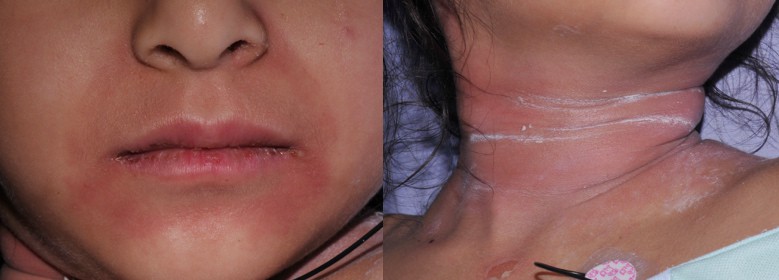
A 5-year-old girl presents to the ED with a rash that started on her face and spread to her neck, axillae, and groin. Mom states that the patient had an upper respiratory infection one week prior. On examination, the patient’s rash is tender to the touch. Which of the following statements regarding the diagnosis of this patient’s condition is correct?
A. Deep layers of the dermis are involved
B. It often leaves the patient disfigured from scarring
C. Mucous membrane involvement is common
D. The disease is caused by an exotoxin producing bacteria
Question 6
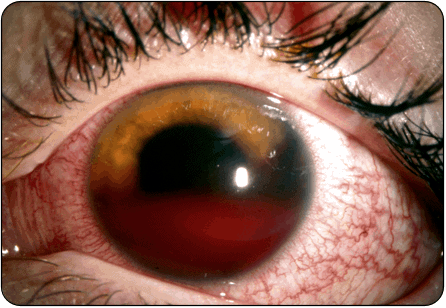
A 22-year-old man complains of pain, photophobia, and vision loss in his eye. He has a history of sickle cell anemia. His vision is 20/200 in the affected eye. Intraocular pressure is 30 mm Hg in the affected eye. You see the above finding on physical exam. Which of the following medications should be immediately administered to this patient?
A. Intravenous ketorolac
B. Intravenous mannitol
C. Topical acetazolamide
D. Topical timolol

- Vision loss is the most concerning clinical feature in patients with temporal arteritis, whereas jaw claudication is the clinical feature that is most likely associated with a positive temporal artery biopsy.
- S1 radiculopathy leads to decreased plantar flexion, numbness to the lateral foot, decreased sensation along the posterolateral calf, and decreased Achilles reflex.
- Hepatorenal syndrome leads to arteriolar constriction and the kidneys here would appear normal histologically.
- The chemical properties of the substance injected is the primary determinant of damage caused by high-pressure injection injury. While air and clean water have a benign course, paint solvents cause the most severe inflammation.
- Staph scalded skin syndrome presents in children less than 5 years old and often follows a URI. The rash starts on the face, neck, axillae, and groin, and there will be a positive Nikolsky sign.
- Patients with a spontaneous hyphema present with decreased visual acuity, elevated intraocular pressure, and an afferent pupillary defect. Immediate treatment is with agents that lower intraocular pressure including topical timolol.
That wraps up RoshCast Episode 52! Creating and producing RoshCast has been a ton of fun, but it also takes a ton of time. We are unfortunately halting production for the time being to focus on other projects. We thank you all for your long-time listenership. And don’t forget that there are 51 other episodes. Listen and re-listen on your commute to work, at the gym, or even just at a desk during dedicated study time.
A huge thanks also goes out to all of the folks at Rosh Review who have worked diligently to create high-quality clinical questions. If you need to reach us, please e-mail Nachi at [email protected]. Be sure to also check out the rest of the Rosh Review Blog for questions from prior episodes, related images, and tables, as well as bonus teaching points.
Jeff, Megha, and Nachi
The post Podcast Ep 52: Temporal Arteritis, Disc Herniations, Hepatorenal Syndrome, High Pressure Injection Injury, Pediatric Rash, Hyphema appeared first on RoshReview.com.
25 February 2019, 1:47 am - 13 minutes 45 secondsEp 51 Roshcast Emergency Board Review
A champion is defined not by their wins but by how they can recover when they fall.
–Serena WilliamsWelcome back to RoshCast for Episode 51! For those of you taking the initial certification exam, you’re at the home stretch. Remember to listen to this episode and old episodes as you get closer to the end for more review. Good luck from us at the RoshCast team! We have a great episode for you to get you prepped in your final studies!
Question 1
A 46-year-old man presents with a progressive dull headache over the past 3 weeks. It is worse in the morning and with bending over or coughing. He denies any fever or congestion. For the last two days, he has had associated nausea and three episodes of vomiting. Which of the following characteristics seen on neuroimaging would be most consistent with a glioblastoma?
A. Heterogenous mass with central necrosis
B. Lack of enhancement with administration of contrast
C. Presence of calcifications
D. Well circumscribed margins
Question 2
A 16-year-old African American boy presents with a scalp rash. On examination, it is a 5 x 5 cm boggy and thickened area of the right parietal cap with an overlying scaly and crusty plaque and hair loss. The lesion appears yellowish-green under a Wood’s lamp. What is the treatment of choice for this lesion?
A. Clotrimazole ointment
B. Ketoconazole shampoo
C. Oral amphotericin B
D. Oral griseofulvin
Question 3
A 22-year-old man recently diagnosed with schizophrenia presents to the ED with altered mental status. His blood pressure is 160/80 mm Hg, pulse 130 beats per minute, and temperature is 39.5°C. He is noted to be confused and diaphoretic. He has muscle rigidity and a tremor in his hands. What is the most likely diagnosis?
A. Malignant hyperthermia
B. Neuroleptic malignant syndrome
C. Serotonin syndrome
D. Tyramine reaction
Question 4
A 21-year-old woman presents with painful urination. She has no vaginal discharge and is not sexually active. Which of the following is most sensitive for a urinary tract infection on urine dipstick testing?
A. Bacteria
B. Blood
C. Leukocyte esterase
D. Nitrites
Question 5
Which of the following findings would be consistent with a diagnosis of tetralogy of Fallot?
A. Bounding pulses and a continuous machine-like murmur
B. Decreased pulses in lower extremities
C. Increased pulmonary vascular markings on chest radiography
D. Loud, single second heart sound with a harsh systolic murmur
Question 6
A 73-year-old man presents with painless vision loss in the right eye. Which of the following on funduscopic examination is most characteristic of central retinal vein occlusion?
A. Cherry red fovea
B. Pale retina
C. Papilledema
D. Retinal hemorrhages

- Glioblastoma is the most common primary malignant brain tumor in adults and presents as a heterogeneous mass with central necrosis.
- A kerion is a boggy, pus-filled lesion caused by a fungal infection on the scalp. It is treated with a 6 to 8-week course of oral griseofulvin.
- New antipsychotic medication administration and a presentation of altered mental status, muscle rigidity, hyperthermia, and autonomic instability is classic for the diagnosis of neuroleptic malignant syndrome.
- On urine dipstick, leukocyte esterase is sensitive while nitrites are specific for a urinary tract infection.
- Tetralogy of Fallot is the most common cyanotic congenital heart disease and is associated with a harsh systolic murmur that improves with squatting.
- Central retinal vein occlusion presents with sudden, painless, monocular vision loss with the classic “blood and thunder” appearance and retinal hemorrhages.
That wraps up RoshCast Episode 51! Be sure to also check out the rest of the Rosh Review Blog for questions from prior episodes, related images, and tables, and bonus teaching points. There are also tons of other great free resources to help prepare you for the boards and the wards. Don’t forget to follow us on twitter @RoshCast. And you can always email us at [email protected] with any feedback, corrections, or suggestions.
You can also help us pick questions by identifying ones you would like us to review. Write “RoshCast” in the submit feedback box as you go through the question bank. Lastly, if you have a minute, make sure to rate us and leave comments on iTunes to help spread the word about RoshCast.
Megha and Nachi
The post Podcast Ep 51: Glioblastoma, Kerion, Antipsychotics, Urine Dipstick, Tetalogy of Fallot, Central Retinal Vein Occlusion appeared first on RoshReview.com.
30 October 2018, 3:21 pm - 17 minutes 54 secondsEp 50 Roshcast Emergency Board Review
A hero is someone who has given his or her life to something bigger than oneself.
–Joseph CampbellWelcome back to RoshCast for Episode 50! Wow!! We can’t believe we’re already at Episode 50. It’s been a real journey building this podcast from the original concept two years ago. And in the last year, we have seen some pretty big changes, including Megha joining the team. We are excited to see how RoshCast continues to evolve over the next fifty episodes and two years.
None of this would be possible without you, our listeners. Your listenership and feedback is what drives us to keep delivering high-quality content! We value every moment you give your attention to us, and we try our best to design the episode to maximize your learning. We have a pretty involved process for choosing questions to present to you and for how we manipulate and deliver the content before we get it to your ears.
With that, let’s kick off a great episode!
Question 1
A 70-year-old woman with history of coronary artery disease, hypertension, and diabetes presents to the emergency department with chest pressure and shortness of breath. Her exam is notable for a new holosystolic murmur best heard over the midaxillary line as well as diffuse bilateral rales. Which of the following is most likely to be seen on this patient’s ECG?
A. Biventricular tachycardia
B. S1Q3T3 pattern
C. ST-depressions in I, V6, and aVL without ST-elevations
D. ST elevations in II, III, aVF
Question 2
A 26-year-old woman with no medical history presents with bleeding gums after brushing her teeth for the last three days. Her complaint was preceded two weeks ago by a URI. Her examination is unremarkable except for oozing from the gums. Labs show a platelet count of 23,000. Which of the following is the most appropriate next step in management?
A. IV immunoglobulin
B. Platelet transfusion
C. Steroids, IV immunoglobulin
D. Steroids, IV immunoglobulin, and platelet transfusion
Question 3
Which of the following is most suggestive of measles infection?
A. A prodrome of fever, lymphadenopathy, and conjunctivitis followed by a maculopapular rash that starts on the face and spreads to the trunk and limbs
B. Diffuse maculopapular rash with white spots on the buccal mucosa
C. High fever for three days followed by the appearance of a pink maculopapular rash after defervescence
D. Presence of shallow ulcers on oral mucosa and vesicular lesions on the palms and soles
Question 4
A 23-year-old man who has unprotected, receptive anal intercourse presents to the ED with two weeks of worsening rectal pain and dyschezia. On exam, he has numerous ulcers in the anorectal area and a crop of grouped vesicles containing clear fluid on an erythematous base. The surrounding skin shows no sign of cellulitis or abscess. Which of the following is the most appropriate next step?
A. Refer the patient to a surgeon for operative intervention
B. Send a serology test
C. Send a Tzanck smear
D. Treat with acyclovir
Question 5
A 5-year-old boy with von Willebrand disease presents with persistent bleeding after he lost a tooth 4 hours ago. Vital signs are unremarkable. Physical exam reveals oozing at the site of the tooth which persists despite pressure. Which of the following is the most appropriate treatment?
A. Desmopressin
B. Factor VIII concentrate
C. Fresh frozen plasma
D. Vitamin K
Question 6
A 70-year-old man with a history of chronic neck pain presents after a fall. On physical examination, he has a laceration on his chin. Motor strength is 2/5 in his upper extremities and 4/5 in his lower extremities. He has decreased sensation to soft touch in both legs. Which of the following is the most likely diagnosis?
A. Anterior cord syndrome
B. Brown-Sequard syndrome
C. Cauda equina syndrome
D. Central cord syndrome

- A new holosystolic murmur over the midaxillary line, with signs of heart failure, is consistent with acute mitral valve regurgitation. Think of inferior stemi as a possible cause here.
- Immune thrombocytopenia presents with bleeding that is often preceded by a viral illness. It is treated with steroids and IVIG in most cases. For those with severe or life-threatening bleeding, platelet transfusion should be considered as well.
- Measles presents with a prodrome of fever and three Cs (coryza, cough, and conjunctivitis) followed by a diffuse maculopapular rash and Koplik spots.
- A painful vesicular rash on an erythematous base in the anorectal area is consistent with herpes simplex proctitis. Diagnosis is clinical. Treat with antivirals.
- von Willebrand disease presents with mucosal bleeding, and the first-line treatment is desmopressin.
- Central cord syndrome is often the result of a hyperextension injury to the cervical spine. It presents with bilateral motor dysfunction that is greater in the upper extremities than the lower extremities.
That wraps up RoshCast Episode 50! Be sure to also check out the rest of the Rosh Review Blog for questions from prior episodes, related images and tables, and bonus teaching points. There are also tons of other great free resources to help prepare you for the boards and the wards. Don’t forget to follow us on twitter @RoshCast. And you can always email us at [email protected] with any feedback, corrections, or suggestions.
You can also help us pick questions by identifying ones you would like us to review. Write “RoshCast” in the submit feedback box as you go through the question bank. Lastly, if you have a minute, make sure to rate us and leave comments on iTunes to help spread the word about RoshCast.
Megha and Nachi
The post Podcast Ep 50: Acute Mitral Regurgitation & More appeared first on RoshReview.com.
16 October 2018, 12:35 pm - 15 minutes 22 secondsEp 49 Roshcast Emergency Board Review
Life is like riding a bicycle. To keep your balance, you must keep moving.
–Albert EinsteinWelcome back to RoshCast for Episode 49! We have a lot of exciting material in this episode. Definitely don’t skip this one! For those taking the initial certification exam, it’s just around the corner. Go back and listen to old episodes and review.
Question 1
A 14-year-old boy developed an itchy, painful, erythematous rash on his hands, forearms, and face about a day after hiking in nearby woods with some friends. Your exam shows linear erythematous papules over his forearms with similar swelling and erythema around his eyes (including eyelids), cheeks, and forehead. You suspect poison ivy that he reports he has had in the past. Which of the following is most likely to improve the course of his illness?
A. Oral diphenhydramine every six hours
B. Three-week prednisone taper
C. Topical 1% hydrocortisone three times daily
D. Topical calamine lotion twice daily
Question 2
Which of the following patients will benefit most from receiving tissue plasminogen activator for acute pulmonary embolism detected in the emergency department?
A. 55-year-old man with a history of hypertension with vital signs showing HR 100/min, BP 80/40 mm Hg, R 24/min, and oxygen saturation 92%
B. 55-year-old man with a history of hypertension with vital signs showing HR 145 bpm, BP 136/86 mm Hg, R 24/min, and oxygen saturation 92%
C. 55-year-old woman with a history of hypertension and systemic lupus erythematosus with vital signs showing HR 100 bpm, BP 116/86 mm Hg, R 24/min, and oxygen saturation 85%
D. 55-year-old woman with a history of hypertension with vital signs showing HR 110 bpm, BP 122/80 mm Hg, R 24/min, and oxygen saturation 92% with evidence of right ventricular dysfunction on echocardiogram
Question 3
A 55-year-old woman presents to the emergency department unresponsive. She and her friend had finished eating 60 minutes earlier when the patient collapsed to the floor while talking. Which of the following foods is most likely the cause?
A. Apricot kernels
B. Fava beans
C. Peanuts
D. Poppy seeds
Question 4
Which of the following is due to the intense thermal radiation seen in lightning strikes?
A. Cataract formation
B. Hypertension and tachycardia
C. Mydriasis
D. Tympanic membrane rupture
Question 5
A 32-year-old woman with no past medical history presents to the emergency department with a four-day history of bloody diarrhea and abdominal cramping. She states that her boyfriend is having similar symptoms but did not want to come to the hospital. Their symptoms started two days after they shared a meal at their favorite fried chicken restaurant. The patient’s vital signs are 37.4℃, HR 89/min, BP 112/70 mm Hg, RR 17/min. Physical examination is significant for moist mucus membranes with brisk capillary refill and mild diffuse tenderness to palpation of the abdomen. Which of the following is the most appropriate management of this patient’s illness?
A. Admit for IV azithromycin and rehydration
B. Admit for IV rehydration and observation for resolution of diarrhea
C. Discharge home with ciprofloxacin
D. Discharge home with metronidazole
Question 6
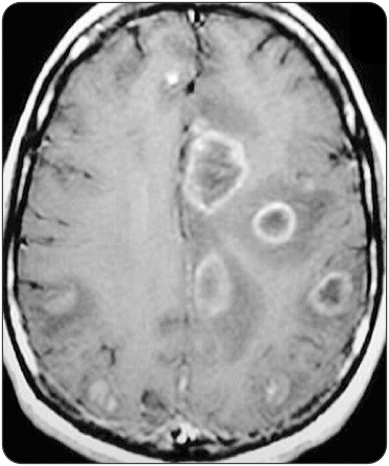
A 54-year-old man with a history of HIV and recent CD4 count of 85 presents with headache for 3 days. The patient’s sister says that he has been increasingly confused over the last 3 days. While in the emergency department, he has a seizure which resolves spontaneously. Electrolytes are within normal limits. A CT scan is performed and is shown above. Which of the following medication regimens should be given?
A. Amphotericin B
B. Ganciclovir and foscarnet
C. Pyrimethamine, sulfadiazine, and leucovorin
D. Trimethoprim-sulfamethoxazole

- Localized reaction from poison ivy can be treated with topical high-potency corticosteroids. Extensive reactions or reactions involving the face or genitalia need a 2–3-week course of tapering systemic steroids.
- Persistent hypotension or shock due to acute pulmonary embolism is the only widely accepted indication for systemic thrombolysis.
- Severe metabolic acidosis is a hallmark feature of cyanide poisoning and treatment is with hydroxycobalamin.
- Lightning strikes cause injuries via both acute thermal radiation and widespread electrical damage. Intense thermal radiation can cause tympanic membrane perforation.
- Undercooked poultry is associated with infection from Campylobacter jejuni. This can present with bloody diarrhea, abdominal cramping, and vomiting. Treatment is with fluoroquinolones or azithromycin.
- Subcortical, ring-enhancing lesions on a CT of the brain in an HIV patient with a CD4 < 100 is indicative of toxoplasmosis and treatment is with pyrimethamine, sulfadiazine, and leucovorin.
- CNS lymphoma also causes ring-enhancing lesions in patients with AIDS but lesions in this case are usually solitary and located in the periventricular white matter. Symptoms are usually gradually progressive over months rather than days.
That wraps up RoshCast Episode 49! Be sure to also check out the rest of the Rosh Review Blog for questions from prior episodes, related images and tables, as well as bonus teaching points. There are also tons of other great free resources to help prepare you for the boards and the wards. Don’t forget to follow us on twitter @RoshCast. And you can always email us at [email protected] with any feedback, corrections, or suggestions.
You can also help us pick questions by identifying ones you would like us to review. Write “RoshCast” in the submit feedback box as you go through the question bank. Lastly, if you have a minute, make sure to rate us and leave comments on iTunes to help spread the word about RoshCast.
Megha and Nachi
The post Podcast Ep 49: Poison Ivy, tPA, Cyanide Poisoning, & More appeared first on RoshReview.com.
2 October 2018, 12:58 pm - 15 minutes 11 secondsEp 48 Roshcast Emergency Board Review
Success is not final, failure is not fatal: it is the courage to continue that counts.
–Winston ChurchillWelcome back to RoshCast for Episode 48! We’re going to jump right into questions this week. Remember to send us feedback for any changes you would like to see at [email protected].
Question 1
An 8-year-old previously healthy boy presents with back pain and fever for 4 days. He complains of pain in the low back, which is increased with bending or twisting. The pain radiates down into his left leg. He denies trauma. Physical exam is remarkable only for tenderness to palpation over the lumbar spine. What management is indicated
A. Ibuprofen and follow up with his pediatrician
B. MRI of the lumbar spine
C. Plain radiographs of the lumbar spine
D. Urinalysis
Question 2
A 40-year-old man is brought to the emergency department after being assaulted during a bar fight. He has proptosis of the right eye with a measured intraocular pressure of 50 mm Hg. A lateral canthotomy is started. Once the Kelly clamp is released from the lateral canthus, what is the appropriate next step?
A. Clamp the medial canthus
B. Cut the inferior crus of the lateral canthal tendon
C. Cut the superior crus of the lateral canthal tendon
D. Recheck intraocular pressure
Question 3
A 25-year-old man presents to the emergency department after sustaining burns to the hands, legs, and chest after falling into a bonfire. On physical examination, there are partial-thickness burns on the upper half of the anterior torso along with the bilateral palms of the hands and bilateral anterior legs. He weighs 70 kg. You begin to initiate fluid resuscitation using the Parkland formula. How much fluid should this patient receive in the first eight hours?
A. 10,640 mL
B. 4,060 mL
C. 5,320 mL
D. 8,120 mL
Question 4
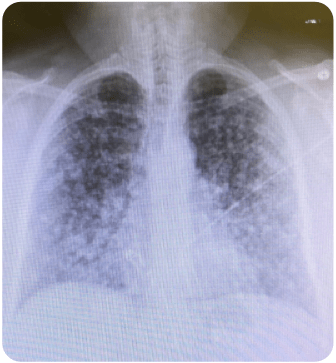
A 64-year-old man presents to the emergency department with cough and shortness of breath that has progressively been worsening over the last several weeks. He has also been more fatigued and is unable to get around the house anymore. He denies fever and night sweats. He has a past medical history of hypertension and takes lisinopril daily. He is an immigrant from Argentina where he used to work as a miner. He denies tobacco use. What is the most likely diagnosis based on this chest radiograph?
A. Histoplasmosis
B. Miliary tuberculosis
C. Pneumoconiosis
D. Sarcoidosis
Question 5
A 53-year-old man presents with numbness to his right hand for three to four months. He states that he has numbness with waking up in the morning, which gets better when he shakes his hands. The patient indicates numbness to his first, second, and third digits on the right hand. Which of the following tests is most sensitive for this diagnosis?
A. Finkelstein test
B. Median nerve compression test
C. Phalen test
D. Tinel sign
Question 6
A young man is involved in a motor vehicle collision and sustains a severe head injury. In the ED, his GCS is 7. His blood pressure is 115/70 mm Hg and heart rate is 85 beats per minute. His pupils are 3 mm and equal and reactive to light. You intubate the patient and place him on a mechanical ventilator. The FAST ultrasound is negative and there are no other obvious injuries. Which of the following is the most important principle to follow in the management of this patient?
A. Administer mannitol
B. Avoid hypotension
C. Hyperventilation
D. Initiate induced hypothermia

- Discitis presents with severe localized radiating pain. The lumbar spine is most commonly involved, and treatment is with IV antibiotics.
- A lateral canthotomy is performed to relieve intraocular pressure from a retrobulbar hematoma or a postseptal hemorrhage. It is done by cutting the inferior crus of the lateral canthal tendon.
- The Parkland Formula is used to determine the volume of fluid required for resuscitation of burn patients. It is 4 mL x body weight in kg x % total body surface area of the burn. Half of this fluid is given within the first 8 hours and then other half over the next 16 hours.
- Pneumoconiosis is a restrictive lung disease that can be caused by inhalation of dust, often in mines. It presents with bilateral ground glass opacities on Chest X-ray.
- The Median Nerve Compression Test is the most sensitive test for confirming carpal tunnel syndrome. It consists of direct pressure application to the median nerve at the carpal tunnel.
- Hypotension and hypoxia have both been shown to have a devastating effect on the outcome of patients with traumatic brain injury.
That wraps up RoshCast Episode 48! Be sure to also check out the rest of the Rosh Review Blog for questions from prior episodes, related images and tables, and bonus teaching points. There are also tons of other great free resources to help prepare you for the boards and the wards. Don’t forget to follow us on twitter @RoshCast. And you can always email us at [email protected] with any feedback, corrections, or suggestions.
You can also help us pick questions by identifying ones you would like us to review. Write “RoshCast” in the submit feedback box as you go through the question bank. Lastly, if you have a minute, make sure to rate us and leave comments on iTunes to help spread the word about RoshCast.
Megha and Nachi
The post Podcast Ep 48: Pediatric Back Pain, Lateral Canthotomy, & More appeared first on RoshReview.com.
18 September 2018, 4:32 pm - 14 minutes 16 secondsEp 47 Roshcast Emergency Board Review
If you fell down yesterday, stand up today.
–H. G. WellsWelcome back to RoshCast for Episode 47! Let’s kick off this episode with a review of Neisseria meningitides, an important topic for clinical practice and personal safety.

- Neisseria meningitides is highly contagious and antibiotic prophylaxis is indicated for close contacts of an infected patient, including those in contact with secretions as well as members of the same household or daycare center.
- Healthcare workers with close contact with the patient’s secretions should also receive prophylaxis.
- There are three options for prophylaxis:
- Rifampin is administered at a dose of 10 mg/kg with a max dose of 600 mg every 12 hours for 4 doses, and this is 100% effective as far as we know.
- Ceftriaxone 250 mg IM can be given for 1 dose, which is 97–100% effective.
- The least effective option is Ciprofloxacin 500 mg PO for 1 dose, and that’s 90–95% effective.
- Even though rifampin is the most effective, be wary of its side effects, which include turning secretions like tears and urine orange. Contact lens wearers should be warned of permanent staining.
Now onto this week’s podcast
Question 1
A 33-year-old woman presents to the ED with agitation and severe respiratory distress. She has been taking a significant amount of “pain medication” for low back pain, according to her son. The patient is screaming about her “ears ringing.” Vital signs are BP 100/60 mm Hg, HR 140 beats per minute, RR 35 breaths per minute, and T 100.1°F. Which of the following complications is she at risk of developing?
A. Hemodynamically significant lower gastrointestinal bleeding
B. Increased intracranial pressure
C. Noncardiogenic pulmonary edema
D. Urinary retention requiring catheterization
Question 2
Which of the following is associated with carbon monoxide poisoning?
A. Bilateral basal ganglia hypodensities
B. Elevated pH
C. Low PO2
D. Odor of bitter almonds
Question 3
A 62-year-old woman presents to the emergency department with dizziness. She describes the events as a spinning sensation that is worse with position changes. The dizziness is associated with hearing loss as well as tinnitus and vomiting. She notes it started three days ago and that she has had multiple episodes all lasting less than a day since that time. On physical examination, horizontal nystagmus is present as is decreased hearing on the left. The remainder of the ear and neurologic examination is within normal limits. A head CT and brain MRI are performed and are negative. Which of the following is the most likely diagnosis?
A. Acoustic neuroma
B. Labyrinthitis
C. Meniere disease
D. Vestibular neuritis
Question 4
A 28-year old woman presents with several painful ulcers she has developed in the vaginal area. Examination reveals multiple 0.5 cm to 1.5 cm oval ulcers with sharply defined borders and a yellowish-white membrane. She denies recent sexual activity. Except for recurring aphthous ulcers of her mouth, her past history is unremarkable. At this time, which of the following is the most likely diagnosis?
A. Behcet syndrome
B. Herpes simplex
C. Reactive arthritis
D. Syphilis
Question 5
A 65-year-old man on peritoneal dialysis presents because his dialysis effluent is cloudy. You send it for culture and Gram staining, which returns with a preliminary result of gram-positive cocci in clusters. Vital signs are BP 125/70 mm Hg, HR 80 bpm, RR 14/min, and T 98.5°F. Other than abdominal ascites, the physical exam is unremarkable. Which of the following is the most appropriate management for this condition?
A. Inpatient management with antibiotics and temporary hemodialysis
B. Inpatient management with IV antibiotics
C. Outpatient management with intraperitoneal antibiotics
D. Outpatient management with oral antibiotics
Question 6
Which of the following historical features is most consistent with infantile spasms?
A. Occur in clusters lasting a few minutes at a time
B. Occur more frequently during sleep
C. Onset between 12 and 18 months of age
D. Precipitated by loud noises or handling

- Salicylates, opioids, naloxone, phencyclidine, and meprobamate can cause noncardiogenic pulmonary edema.
- Patients with acute salicylate toxicity with levels greater than 100 mg/dL and chronic toxicity with levels greater than 60 mg/dL require dialysis.
- Neurologic sequelae from carbon monoxide poisoning can be identified radiographically within 12 hours of exposure as symmetric hypodense lesions in the basal ganglia.
- Meniere disease is a set of episodic symptoms including vertigo, hearing loss, tinnitus, and a sense of fullness in the ear. Episodes last anywhere from 20 minutes to 4 hours.
- Behcet syndrome presents as recurring genital and oral ulcerations and also relapsing uveitis.
- Peritonitis is the most common complication of peritoneal dialysis, and it can often be treated with intraperitoneal antibiotics as an outpatient.
- Infantile spasms present before the age of one and EEG shows hypsarrhythmia. This is treated with corticotropin.
That wraps up RoshCast Episode 47! Be sure to also check out the rest of the Rosh Review Blog for questions from prior episodes, related images and tables, and bonus teaching points. There are also tons of other great free resources to help prepare you for the boards and the wards. Don’t forget to follow us on twitter @RoshCast. And you can always email us at [email protected] with any feedback, corrections, or suggestions.
You can also help us pick questions by identifying ones you would like us to review. Write “RoshCast” in the Submit Feedback box as you go through the question bank. Lastly, if you have a minute, make sure to rate us and leave comments on iTunes to help spread the word about RoshCast.
Megha and Nachi
The post Podcast Ep 47: Salicylate Toxicity, Carbon Monoxide Poisoning, & More appeared first on RoshReview.com.
4 September 2018, 10:30 pm - 14 minutes 43 secondsEp 46 Roshcast Emergency Board Review
Only those who dare to fail greatly can ever achieve greatly.
–Robert F. KennedyWelcome back to RoshCast for Episode 46! Let’s kick off this episode with a rapid review of molluscum contagiosum.

- Molloscum contagiosum is caused by poxvirus. It is seen in children, sexually active adults, and immunocompromised patients like those with HIV.
- The rash presents as painless, pearly, umbilicate papules, and it is spread by direct skin-to-skin contact.
- Children present with lesions on the face, trunk, and extremities, whereas sexually active adults can present with lesions in the genital regions, lower abdomen, and thighs. The rash tends to spare the palms and soles.
- Most patient will not require therapy with spontaneous resolution occurring in months. Those with extensive lesions may benefit from cryotherapy.
- HIV positive patients with a CD4 count less than 100 are at greater risk for developing molluscum contagiosum.
Now onto this week’s podcast
Question 1
Which of the following organisms is one of the most commonly implicated in the development of a lung abscess?
A. Klebsiella pneumoniae
B. Peptostreptococcus
C. Staphylococcus aureus
D. Streptococcus pneumoniae
Question 2
A 26-year-old man presents to the ED after being hit in the head by a foul baseball. The patient was initially alert and talking to you. He is now becoming progressively more somnolent. Which of the following would you expect to see on a non-contrast computed tomography scan of the head?
A. A collection of blood layering in the basilar cisterns
B. A crescent-shaped frontal hematoma crossing suture lines
C. A lenticular-shaped hematoma in the temporal region
D. An intraparenchymal hemorrhage within the frontal lobe
Question 3
A 55-year-old man who is taking several antihypertensive medications presents to the ED with nausea, vomiting, shortness of breath, and a rash after eating a home-cooked Thai meal at a friend’s house about one hour ago. The symptoms began within seconds of the first bite of his meal. Despite the patient being administered 2 doses of intramuscular epinephrine, diphenhydramine, dexamethasone, and crystalloid fluids, his blood pressure remains at 75/38 mm Hg. Which other medication should be considered in this patient?
A. Cimetidine
B. Glucagon
C. Norepinephrine
D. Octreotide
Question 4
A 36-year-old man presents to the ED after having a seizure. He has a folder full of medical records dating back 15 years. Several of the records are from other cities and states. It is now 11:00 pm on a Friday night. His primary care physician, neurologist, and psychiatrist are “out of town,” and he believes that he needs to be admitted for the duration of the weekend. He has another episode in the ED and immediately following this he returns to his baseline. He is now awake and alert. You immediately draw a serum lactate and it is normal. Which of the following diagnoses should be strongly considered in this patient?
A. Conversion disorder
B. Hypochondriasis
C. Munchausen syndrome
D. Somatization
Question 5
A 4-year-old boy is brought to the emergency department by his parents after they found him in the backyard shed choking and gagging. Before this event, he was otherwise healthy. His temperature is 101°F, heart rate is 95 bpm, blood pressure is 100/60 mm Hg, and respiratory rate 40/min. On exam, he appears sleepy but continues to cough. Pulmonary findings include moderate retractions and diffuse wheezes. A chest X-ray shows patchy infiltrates. What is the most likely diagnosis?
A. Foreign body aspiration
B. Hydrocarbon ingestion
C. Organophosphate ingestion
D. Status asthmaticus
Question 6
A 12-year-old boy presents to the ED after his brother bumped into his elbow while he was using a cotton-tipped swab to clean out his ear. He denies dizziness, vertigo, nausea, or hearing loss. On exam, you note a tear of the tympanic membrane and a small amount of blood in the external canal. Which of the following is the most appropriate next step in management?
A. Begin antibiotics
B. Discharge with instructions to keep the ear canal dry
C. Emergency department consultation to ENT
D. Pack the ear with gauze

- Anaerobes like Prevotella, Bacteroides, Fusobacterium, and Peptostreptococcus are the most common organisms found in a lung abscess.
- On chest radiograph, lung abscesses present as a consolidation with an air fluid level inside a cavitary lesion.
- An epidural hematoma presents as a hyperdense lenticular-shaped hematoma in the temporal region, and it is caused by a tear in the middle meningeal artery. A lucid interval is often associated with this bleed.
- Patients taking beta-blockers for hypertension may exhibit persistent hypotension in the setting of anaphylactic shock. They should be treated with glucagon to free up the beta receptor and potentiate the circulating epinephrine to restore vasomotor tone.
- In Munchausen syndrome, the individual feigns disease in an attempt to gain attention, sympathy, or reassurance.
- Somatization disorder is characterized by unexplained physical symptoms that lead to significant social and occupational impairment.
- Conversion disorder is characterized by an unexplained neurologic symptom triggered by a psychological stressor.
- Hydrocarbon ingestion can cause pneumonitis, and the chest X-ray can show diffuse bilateral infiltrates.
- Patients with asymptomatic ruptured tympanic membranes can be discharged home with instructions to keep the canal dry. Symptomatic patients require emergent ENT consultation.
That wraps up RoshCast Episode 46! Be sure to also check out the rest of the Rosh Review Blog for questions from prior episodes, related images and tables, and bonus teaching points. There are also tons of other great free resources to help prepare you for the boards and the wards. Don’t forget to follow us on twitter @RoshCast. And you can always email us at [email protected] with any feedback, corrections, or suggestions.
You can also help us pick questions by identifying ones you would like us to review. Write “RoshCast” in the Submit Feedback box as you go through the question bank. Lastly, if you have a minute, make sure to rate us and leave comments on iTunes to help spread the word about RoshCast.
Megha and Nachi
The post Podcast Ep 46: Lung Abscesses, Head Injuries, Anaphylaxis & More appeared first on RoshReview.com.
21 August 2018, 6:37 pm - 17 minutes 24 secondsEp 45 Roshcast Emergency Board Review
There is only one corner of the universe you can be certain of improving, and that’s your own self.
–Aldous HuxleyWelcome back to RoshCast for Episode 45! Let’s start out with a review of rabies before getting to core content Q&A.

- The most common wild reservoirs of rabies are raccoons, skunks, bats, foxes, and coyotes. Domestic animals like cats, dogs, and cattle can also get rabies. Rodents, reptiles, and birds on the other hand are not carriers and cannot transmit rabies.
- One important factor in deciding if you get rabies postexposure prophylaxis is whether the animal can be found and held for observation.
- The rabies postexposure prophylaxis has two parts: the immunoglobulin and the vaccine.
- When giving rabies postexposure prophylaxis, inject the immunoglobulin into the wound and start the rabies vaccine series which the patient will receive on days 1, 3, 7, 14, and 28.
Now onto this week’s podcast
Question 1
Which of the following is true regarding acute respiratory distress syndrome?
A. Define as PaO2:FiO2 > 300
B. Empiric corticosteroids should be given
C. Positive end-expiratory pressure should be increased with increases in FiO2
D. Tidal volume should be started at 10 mL/kg in intubated patients
Question 2
A 35-year-old man presents to the ED after being assaulted in a bar fight. He has signs of significant facial trauma. On physical exam, you note a tooth fracture through the enamel and dentin but does not involve the pulp. Which of the following is the most appropriate next step in management of his dental injury?
A. Calcium hydroxide paste
B. Extract the tooth
C. Immediate dental consult
D. Pencillin VK
Question 3
A 62-year-old man presents with acute onset of chest pain with radiation to the shoulders and nausea while walking his dog. On examination, he is diaphoretic with heart rate 94 bpm, respiratory rate 20 bpm, blood pressure 92/59 mm Hg, and oxygen saturation 96% on room air. His ECG reveals 2 mm elevation in aVR. Occlusion of which coronary artery is most likely responsible for this patient’s presentation?
A. Left anterior descending artery
B. Left circumflex artery
C. Left main coronary artery
D. Right coronary artery
Question 4
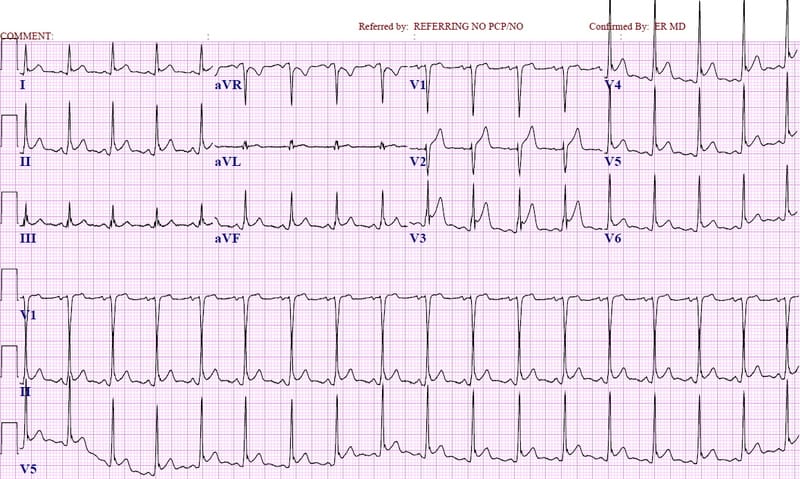
A 62-year-old man presents for evaluation of chest pain. Approximately three weeks ago the patient had a myocardial infarction with stent placement. Last evening he developed pleuritic chest pain and fever. He has no cough and does not feel short of breath. His ECG is shown above. Which of the following is the most likely diagnosis?
A. Dressler syndrome
B. Infarct pericarditis
C. Left ventricular aneurysm
D. ST segment elevation myocardial infarction
Question 5
A 45-year-old man with a history of hypercholesterolemia presents with acute onset of anterior chest pain, nausea, and diaphoresis. His ECG is distinct for upsloping ST elevation in AVR (≥ 1 mm) with ST depressions and tall T waves in the precordial leads. What is the most likely diagnosis?
A. Occlusion of the left circumflex artery
B. Occlusion of the left main coronary artery
C. Occlusion of the proximal left anterior descending artery
D. Occlusion of the right coronary artery
Question 6
A 25-year-old man presents the emergency department with knee pain. This morning he slipped on the ice and felt a pop in his knee. On physical exam his left knee appears to have a moderate effusion with limited range of motion and medial joint line tenderness. An X-ray of the left knee is performed. A pedunculated, bony exostosis with well-defined margins is seen along the distal lateral femur on the AP view of the knee. What is the most likely diagnosis of the incidental bone lesion?
A. Aneurysmal bone cyst
B. Osteochondroma
C. Osteoid osteoma
D. Osteosarcoma

- Intubated patients with ARDS should be started on low tidal volumes of 6–8 cc/kg of ideal body weight, and the PEEP and FiO2 should be titrated up together.
- The PaO2 to FiO2 ratio in patients with ARDS is < 300. The lower the ratio, the worse the disease process.
- There are three classes of dental fractures:
- Ellis Class I involves injury to the enamel alone and is treated by smoothing any rough edges.
- Ellis Class II involves injury to the dentin and enamel. This is treated by covering exposed dentin with calcium hydroxide.
- Ellis Class III involves the pulp along with the dentin and enamel. These usually require antibiotics and immediate dental consult.
- ST segment elevation in aVR greater than 1 mm or greater than the ST segment elevation in V1 is most concerning for occlusion of the left main coronary artery.
- Dressler syndrome is pericarditis occuring one week to several months after an MI.
- A left ventricular aneurysm is a complication of a large anterior wall MI. EKG shows ST segment elevations in the anterior leads.
- De Winter ECG patterns presents with tall, prominent symmetric T waves in the precordial leads with upsloping ST segment depression greater than 1mm at the J point and ST segment elevation may be seen in aVR
- De Winter EKG is a STEMI equivalent and represents acute LAD occlusion.
- Aneurysmal bone cyst, osteochondroma, and osteoid osteoma are benign bone lesions.
- Osteosarcoma is a malignant bone lesion seen on X-ray as a lytic lesion, a blastic lesion, or a heavily ossified mass.
That wraps up RoshCast Episode 45! Be sure to also check out the rest of the Rosh Review Blog for questions from prior episodes, related images and tables, as well as bonus teaching points. There are also tons of other great free resources to help prepare you for the boards and the wards. Don’t forget to follow us on twitter @RoshCast and @RoshReview. And you can always email us at [email protected] with any feedback, corrections, or suggestions.
You can also help us pick questions by identifying ones you would like us to review. Write “RoshCast” in the submit feedback box as you go through the question bank. Lastly, if you have a minute, make sure to rate us and leave comments on iTunes to help spread the word about RoshCast. We’re also launching on Google Play in the near future.
Megha and Nachi
The post Podcast Ep 45: ARDS, Dental Fractures, STEMIs, Pericarditis, & More appeared first on RoshReview.com.
7 August 2018, 8:14 pm - 16 minutes 48 secondsEp 44 Roshcast Emergency Board Review
By failing to prepare, you are preparing to fail.
–Benjamin FranklinWelcome back to RoshCast for Episode 44! We are back to an every other week schedule covering core content. Let’s start out with a rapid review of neonatal conjunctivitis.

- The three dangerous causes of neonatal conjunctivitis that you need to consider in the ED are gonorrhea, chlamydia, and herpes.
- Gonorrhea is the most aggressive bacteria associated with neonatal conjunctivitis. It presents in the first week of life with purulent drainage and ulcerations, and it can disseminate to cause gonococcal sepsis. Culture the drainage for confirmation, and treat the baby with cefotaxime.
- Chlamydia neonatal conjunctivitis, which presents in the first month of life, can disseminate into the lungs. Treat with oral erythromycin.
- The third and least dangerous cause of neonatal conjunctivitis is herpetic. In this case you may see vesicles in the eye. Treat this with IV acyclovir.
Now onto this week’s podcast
Question 1

A 21-year-old man presents after he was bitten by a spider. He has a picture of the spider on his phone (shown above). Which of the following is a potential complication of a bite by this spider?
A. Abdominal rigidity
B. Autonomic instability
C. Coagulation abnormalities
D. Pancreatitis
Question 2
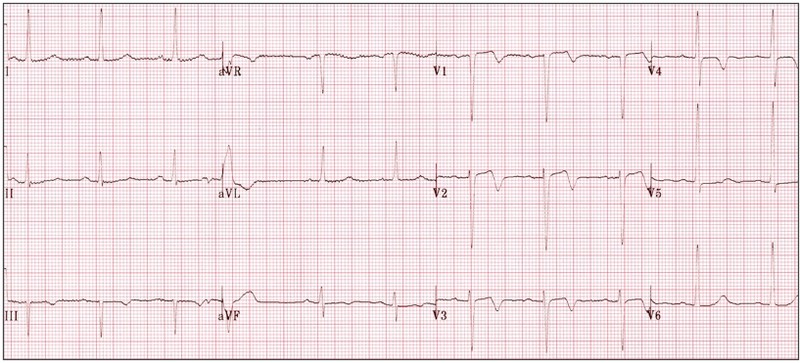
A 66-year-old man with hypertension and hyperlipidemia presents after an episode of severe chest pain while walking to work. He is currently asymptomatic. His vitals are T 36.27°C, HR 76/min, BP 143/85 mm Hg, RR 18/min, and oxygen saturation 99%. A 12-lead ECG is performed as seen above. Which of the following is the most appropriate next step in management?
A. Give 325 mg of aspirin, and activate the cardiac catheterization lab
B. Give 325 mg of aspirin, and admit for serial troponin testing and stress test
C. Give 325 mg of aspirin, and discharge home with cardiology follow-up in 24–48 hours
D. Send d-dimer, and consider CT pulmonary angiogram if elevated
Question 3
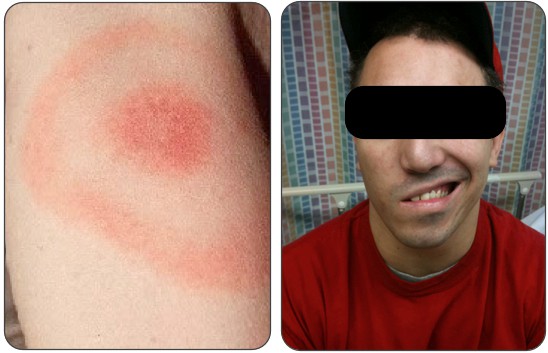
A 17-year-old boy from New Jersey presents with a 3-day history of rash and a 1-day history of facial droop. He also complains of a headache. The images above represent the physical examination findings. In addition you note mild nuchal rigidity. A noncontrast head CT is performed and is normal. Which of the following is the next best step for this patient?
A. Acyclovir and corticosteroids
B. Lumbar puncture
C. MRI brain
D. Serologic testing for Lyme disease
Question 4
A 52-year-old man presents with decreased sensation in the upper extremities and chronic neck pain. He states that the loss of sensation has been progressive for months. On physical examination, he has decreased sensation to pain over the upper back, shoulders, and arms with intact proprioception and light touch. What disorder does this patient exhibit?
A. Anterior cord syndrome
B. Brown-Sequard syndrome
C. Central cord syndrome
D. Syringomyelia
Question 5
What is the most frequently seen oculomotor sign in patients with Wernicke encephalopathy?
A. Lateral nystagmus
B. Lateral rectus palsy
C. Miosis
D. Ptosis
Question 6
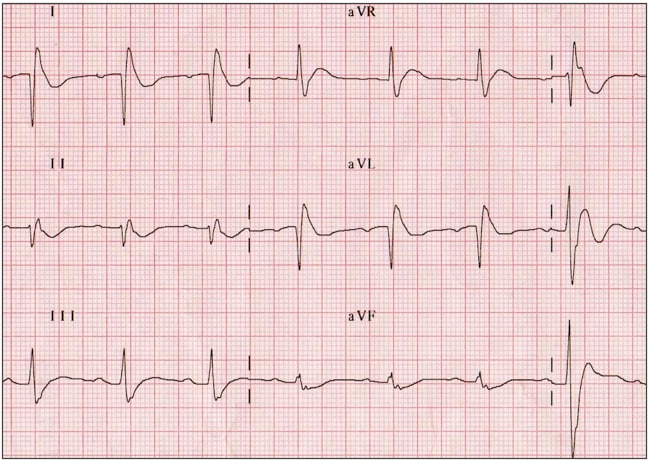
A patient with metastatic breast cancer presents with weakness and nausea. An ECG is shown above. What electrolyte abnormality is likely in this patient?
A. Hypercalcemia
B. Hypernatremia
C. Hypocalcemia
D. Hyponatremia

- Brown recluse spiders have violin-shaped markings on their back. The toxin here can lead to hematologic abnormalities. There is no antivenin available in the US.
- Black widow spiders, on the other hand, have a red hourglass shape on their ventral surface and their toxin causes autonomic instability and abdominal wall rigidity. There is an antivenin available, but it’s only used in severe cases.
- Wellen’s syndrome type A demonstrates biphasic T waves in V1–V3 and type B demonstrates deeply inverted T waves in V1–V3. It is highly specific for a critical stenosis of the LAD. Activate the catheterization lab!
- There are three stages of Lyme disease:
- Early Lyme manifests with the classic erythema migrans rash.
- The second stage is acute disseminated infection which results in neurologic, cardiac, arthritic, and ophthalmic manifestations.
- The third is late Lyme disease, which presents with worse neurologic manifestations and chronic Lyme arthritis.
- The most common location of syringomyelia is the cervical spine. Patients present with a cape-like distribution of loss of pain and temperature sensation in the upper extremities with preservation of light touch and proprioception.
- Anterior cord syndrome is characterized by loss of motor function below the lesion and preservation of position, touch, and vibration sensation.
- Brown-Sequard syndrome presents with ipsilateral motor function loss and contralateral pain and temperature sensation loss.
- Central cord syndrome presents with bilateral motor paresis and sensory impairment.
- The most frequently seen oculomotor sign in Wernicke encephalopathy is lateral nystagmus.
- Diagnosis of Wernicke encephalopathy requires two out of four of the following criteria: dietary deficiencies, oculomotor dysfunction, cerebellar dysfunction, and altered mental status.
- Hypercalcemia can cause QT shortening, while hypocalcemia can cause QT prolongation.
- Malignancy is the most common inpatient cause of hypercalcemia while primary hyperparathyroidism is the most common outpatient cause.
That wraps up RoshCast Episode 44! Be sure to also check out the rest of the Rosh Review Blog for questions from prior episodes, related images and tables, as well as bonus teaching points. There are also tons of other great free resources to help prepare you for the boards and the wards. Don’t forget to follow us on twitter @RoshCast and @RoshReview. And you can always email us at [email protected] with any feedback, corrections, or suggestions.
You can also help us pick questions by identifying ones you would like us to review. Write “RoshCast” in the submit feedback box as you go through the question bank. Lastly, if you have a minute, make sure to rate us and leave comments on iTunes to help spread the word about RoshCast. We’re launching on Google Play in the near future also.
Megha and Nachi
The post Podcast Ep 44: Spider Bites, Biphasic T Waves, Lyme Disease, Syringomyelia, Wernicke Encephalopathy, Electrolyte Abnormalities appeared first on RoshReview.com.
24 July 2018, 5:59 pm - 14 minutes 27 secondsEp 43 Roshcast Emergency Board Review
Always do your best. What you plant now, you will harvest later.
–Og MandinoWelcome back to RoshCast for Episode 43! After a long pause, we are back with new episodes and a lot of announcements. A lot has happened in the past few months. Jeff had a baby and moved to Pittsburg to start his EMS fellowship. In doing so, he is taking a break from Roshcast to focus on fellowship and his new baby. Megha Rajpal, a fourth-year resident at Mount Sinai, will be taking over as co-host.

- For epiglottitis, the patient will usually have a rapid-onset fever and dysphagia. On exam, they could be leaning forward, drooling, and even have inspiratory stridor.
- The typical radiographic finding for epiglottitis is thumbprint sign, which is seen on a lateral neck film.
- The most common bacteria associated with epiglottitis are H. influenzae and Streptococcus.
- For management in epiglottitis, airway is the crucial piece. Patients may need to be intubated immediately. Don’t forget to start the patient on antibiotics to treat for the common pathogens.
Now onto this week’s podcast
Question 1
Which of the following is the most common presenting vital sign abnormality seen in patients presenting with a pulmonary embolism?
A. Fever
B. Hypoxia
C. Tachycardia
D. Tachypnea
Question 2
A 72-year-old man presents with pain in the right knee. It has increased over the last 24 hours with redness and swelling. Joint aspiration reveals negative birefringent crystals. He reports an allergy to NSAIDs and is a brittle diabetic. Colchicine is prescribed. Which side effect limits its usefulness due to a narrow therapeutic window?
A. Headache
B. Nausea and vomiting
C. Rash
D. Sore throat
Question 3
A patient presents to the ED after waking up and finding that he was drooling while drinking his coffee. When he looked in the mirror he noticed that the left side of his face was drooping. Which of the following findings is suggestive of a central process?
A. Hyperacusis of the left ear
B. Inability to close the left eye completely
C. Loss of taste sensation
D. Preserved ability to raise the eyebrows
Question 4
Which of the following is considered a stable cervical spine injury?
A. Bilateral facet dislocation
B. Clay-shoveler’s fracture
C. Hangman fracture
D. Teardrop fracture
Question 5
A 28-year-old man presents to the emergency department via ambulance after a terrorist set off a large bomb in an airport. On physical exam, he has bilateral tympanic membrane ruptures. Chest X-ray shows bilateral pulmonary contusion. These injuries are most consistent with which category of blast injury?
A. Primary
B. Quaternary
C. Secondary
D. Tertiary
Question 6
A 19-year-old man presents with eye pain and photophobia in his left eye after being punched there two days ago. He describes blurry vision. On exam, you note consensual photophobia. Which of the following is the most appropriate treatment?
A. Homatropine drops
B. Timolol
C. Topical ketorolac drops
D. Topical vasoconstrictor

- Tachypnea is the most common presenting vital sign abnormality for a pulmonary embolism, while dyspnea at rest or exertion is the most common presenting symptom.
- Joint aspiration in gout demonstrates negative birefringent monosodium urate crystals. NSAIDs are the first-line treatment.
- Colchicine can cause severe GI symptoms in more than 10% of patients.
- When deciding on a central versus peripheral etiology for facial paralysis, preserved ability to raise the ipsilateral eyebrow or close the ipsilateral eye is more concerning for a central lesion than a peripheral lesion.
- Clay shoveler’s fracture is a stable avulsion fracture of the spinous process of C6–C7.
- Jefferson burst fracture, bilateral facet dislocation, odontoid type II and type III fractures, any fracture with a dislocation, hangman’s fracture, and teardrop fracture are all unstable cervical spine fractures.
- Primary blast injury occurs from direct effect from blast shockwaves.
- Secondary blast injury occurs from the impact of fragments due to exploding devices.
- Tertiary blast injury occurs when the blast wave propels the body into objects.
- Quaternary blast injury is due to environmental contamination from the device.
- In quinary blast injuries, there is bodily absorption of device additives.
- Traumatic iritis is treated using cycloplegics like homatropine and topical steroids.
That wraps up RoshCast Episode 43! Rosh Review is excited to announce the launch of a new podcast called The PA Way hosted by Alison Callahan, PA-C. Definitely worth a listen. Be sure to also check out the RoshCast blog for questions from this episode and prior episodes, related images and tables, as well as bonus teaching points. There are also tons of other great free resources there to help prepare you for the boards and the wards.
Don’t forget to follow us on twitter @RoshCast and @RoshReview. And you can always email us at [email protected] with any feedback, corrections, or suggestions. You can also help us pick questions by identifying ones you would like us to review. Write “RoshCast” in the submit feedback box as you go through the question bank. Lastly, if you have a minute, make sure to rate us and leave comments on iTunes to help spread the word about RoshCast.
Megha and Nachi
The post Podcast Ep 43: Pulmonary Embolism, Colchicine & More appeared first on RoshReview.com.
10 July 2018, 4:07 pm - More Episodes? Get the App
Your feedback is valuable to us. Should you encounter any bugs, glitches, lack of functionality or other problems, please email us on [email protected] or join Moon.FM Telegram Group where you can talk directly to the dev team who are happy to answer any queries.
 Academic Life in Emergency Medicine (ALiEM) Podcast
Academic Life in Emergency Medicine (ALiEM) Podcast
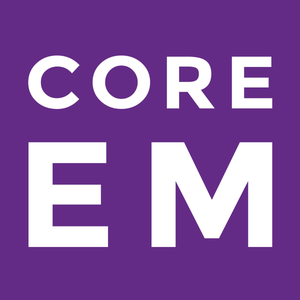 Core EM - Emergency Medicine Podcast
Core EM - Emergency Medicine Podcast
 EM Clerkship
EM Clerkship
 CanadiEM Podcasts: CRACKCast, ClerkCast, CarmsCast, First Year Diaries
CanadiEM Podcasts: CRACKCast, ClerkCast, CarmsCast, First Year Diaries
 EMplify by EB Medicine
EMplify by EB Medicine
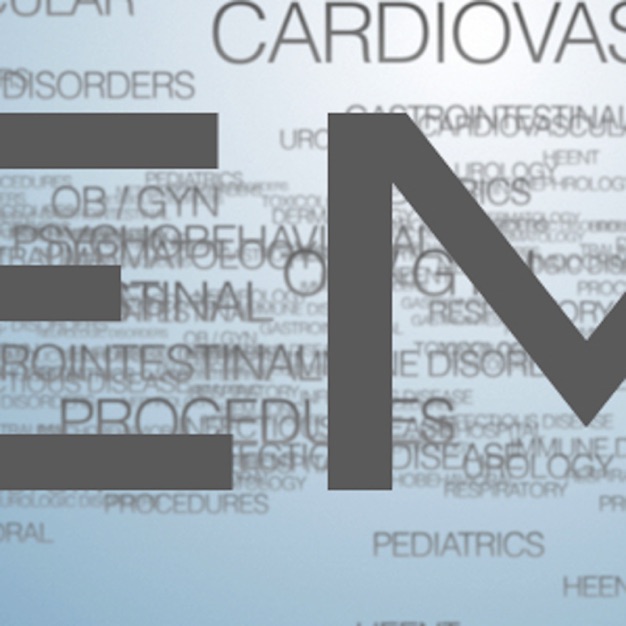 Emergency Board Review
Emergency Board Review